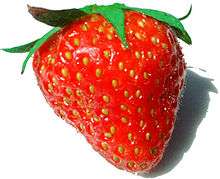Accessory fruit

An accessory fruit (sometimes called false fruit, spurious fruit, pseudofruit, or pseudocarp) is a fruit in which some of the flesh is derived not from the ovary but from some adjacent tissue exterior to the carpel.[1] Examples of accessory tissue are the receptacle of the strawberry, pineapple, common fig, and mulberry, and the calyx of Gaultheria procumbens or Syzygium jambos. Pomes, such as apples and pears, are also accessory fruits, with much of the fruit flesh derived from a hypanthium.[2] Other example could be the anthocarps specific to the family Nyctaginaceae, where most of the fruit comes from the perianth (floral whorls).
Fruit with fleshy seeds, such as pomegranate or mamoncillo, are not considered to be accessory fruit.
The terms false fruit, spurious fruit, and pseudocarp are older terms for accessory fruit that have been criticized as "inapt",[1] and are not used by botanists today.
See also
References
- 1 2 Esau, K. 1977. Anatomy of seed plants. John Wiley and Sons, New York.
- ↑ Merriam Webster Collegiate Dictionary entries for syconium, accessory fruit, core, and strawberry, Merriam-Webster, Inc., 2006